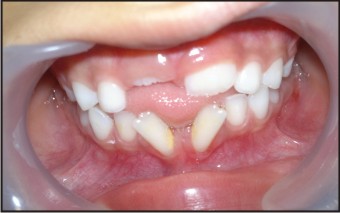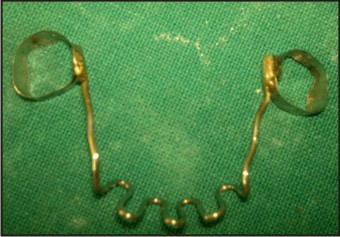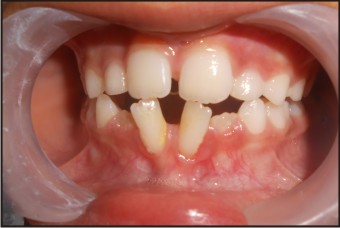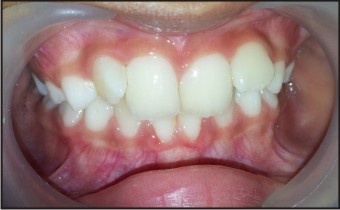Introduction
Oral habits as defined by Boucher is the tendency towards an act or as act that has become a repeated performance relatively fixed, consistent, easy to perform and almost automatic. Tulley [1] (1969) defines tongue thrust as the forward movement of the tongue tip between the teeth to meet the lower lip during deglutition and in sounds of speech, so that the tongue becomes interdental.
Fletcher[2], [3] (1975) has given various etiological factors which play significant role in development of tongue thrusting habit. It can occur due to genetic predilection, or as a part of learned pattern due to preexisting habits such as thumb sucking. He also noted that persistence of infantile swallowing pattern even after eruption of deciduous teeth and mechanical constrictions such as macroglossia or enlarged tonsil and adenoids contributed to thrusting of tongue. Abnormal feeding practices such as prolonged bottle feeding as well as certain neurologic disturbances with motor disabilities also contribute to development of habit.
Fletcher reported the incidence rates of tongue thrusting was 52.3% in 6 -7 years of age and it reduced to 34% at age of 10 years. Transition towards adult swallowing pattern is influenced by persistent other deleterious habits such as digit sucking and also by the presence of existing skeletal malocclusion. The prevalence of the deleterious oral habits in children aged 5- 13 years in India has been reported to be as high as 25.5%, where the tongue thrusting was the commonest habit accounting for 18.1% of cases.[4]
Case Report
A 7 year old girl reported to the department of Pedodontics and Preventive Dentistry , Himachal Dental College, Sundernagar with the chief complain of irregularly placed teeth in the lower jaw. On examination, severe anterior open bite was evident. There was severe flaring of mandibular central incisors making an angle of 45- 50 degree with midline diastema of 9 mm (Figure 1). The patient used to thrust her tongue forward into the space when asked to swallow. Parents gave history of thumb sucking habit for the child.
 | Figure 1: Preoperative Picture Depicting Thrusting Effect Of Tongue On Mandibular Incisors ( Note The Flaring Of Mandibular Central Incisors And Diastema).
 |
As the habit is the prime culprit in causing malocclusion in this case, mere interception of habit will restore the muscular balance in the oral cavity which will favor the correction the malocclusion without any active intervention. The palatal crib (Figure 2) is the appliance of choice as it is the fixed appliance which modulates the tongue position and/ or breaks the persistent habit. The fixed appliance was planned because the thrusting effect was severe and patient might not wear a removable appliance.
 | Figure 2: Fixed Palatal Crib
 |
Discussion
As the parents gave the history of patients persistent thumb sucking, we believe that it was the first assault to the integrity of the dental arches and compensatory muscle activity of tongue and lips develops which further aggravates the deformity. Since, the maxillary incisors were erupting, the entire thrusting force was subjected to mandibular incisors creating such a huge diastema and flaring of mandibular incisors. (Figure 1-5) Due to incompetent resting lip posture, the tongue has to thrust forward to aid in closure of lower lip during swallowing.[5]
 | Figure 3: Mid-treating Picture Showing Eruption Of Maxillary Incisors And Closure Of Midline
 |
 | Figure 4: Further Closure Of Midline Diastema And Flaring Of Mandibular ( Self Correction)
 |
 | Figure 5: Post Operative Picture Depicting Closure Of Mandibular Midline Diastema
 |
When the tongue is positioned anteriorly, it thrusts the maxillary anterior teeth causing their protrusion, followed by increased in overjet. As the tongue protrudes anteriorly, it is not able to balances the forces of buccinators muscle causing constriction of maxillary arch resulting in posterior cross bite.[6],[7],[8] At the same time, habit impedes the vertical eruption of teeth as the lateral border of the tongue is not spread well along the posterior segment of teeth resulting in open bite[9] (Figure 1). The tongue thrusting patient will have lisping sound when talking with other person. The parents gave history of thumb sucking habit which led to the development of tongue thrust habit. In classical condition of tongue thrust habit there may be generalized spacing in maxillary and mandibular incisors with proclined maxillary anterior teeth.[10]
The arena of controversy lies in saying that whether the habit precedes malocclusion or malocclusion precedes habit. The classical features of tongue thrust habit as mentioned above were absent in this particular case, hence it was very interesting. It may be mentioned here that the maxillary central incisors were erupting and the effect of tongue thrust on maxillary anterior teeth were absent. We interrupted the deleterious habit as soon as possible to get self correction of malocclusion (Figure 3-5). The present case has got strong thrusting force causing severe malocclusion in the mandibular incisors resulting in flaring of the teeth and a huge midline diastema which is not usually seen in routine cases of tongue thrust habit.
Thus, the therapy aims towards establishing reflex which will rest the tongue in its normal superior position. The tongue thrust appliance will prevent the position of tongue at its normal area (palatal rugae), the anterior open bite should be corrected. The tongue thrust appliance offers the physical obstruction to the forceful anterior movement of the tongue during swallowing which will prevent proclination of incisors. Due to more backward position of the tongue, the dorsum of the tongue now contacts the palatal vault and the tip contacts the rugae area. Thus the tongue now exerts lateral pressure on the maxillary buccal teeth thereby preventing narrowing of the arches. As the appliance prevents forceful effect to the maxillary incisors, it should allow correction of proclined incisors tooth. This finding is in agreement with various authors as mentioned above.
References
1. Tulley WJ. A critical appraisal of tongue-thrusting. Am J Orthod1969;55:640-50.
2. Traisman AS, Traisman HS. Th umb- and fi nger-sucking: A study of 2,650 infants and children. J Pediatr 1958;52:566-72.
3. Shankar G. Tongue thrust habit – A review. Ann Essences Dent 2009;1(2):14-23.
4. Kharbanda OP, Sidhu SS, Sundaram K, Shukla DK. Oral habits in school going children of Delhi: A prevalence study. J Indian Soc Pedod Prev Dent 2003;21:120-4.
5. Proffit WR. The etiology of orthodontic problems. In: Proffit, WR, ed. Contemporary Orthodontics. 2nd ed. St. Louis, Mo:Mosby; 1993:128.
6. Klein J. Pressure habits, etiological factors in malocclusion. Am J Orthod 1952;38:569-87.
7. Weiss CE. A directional change in tongue thrust. Int J Lan Com Dis 1972;7:131-4.
8. Burford D, Noar JH. Etiological aspects of anterior open bite. Dentupdate 2003;30:235-41.
9. Speidel TM, Isaacson RJ, Worms FW. Tongue-thrust therapy and anterior dental open-bite. A review of new facial growth data. Am J Orthod 1972;62:287-95.
10. Graber TM. The “three Ms:” muscles, malformation, and malocclusion. Am J Orthod 1963;49:418-50.
|